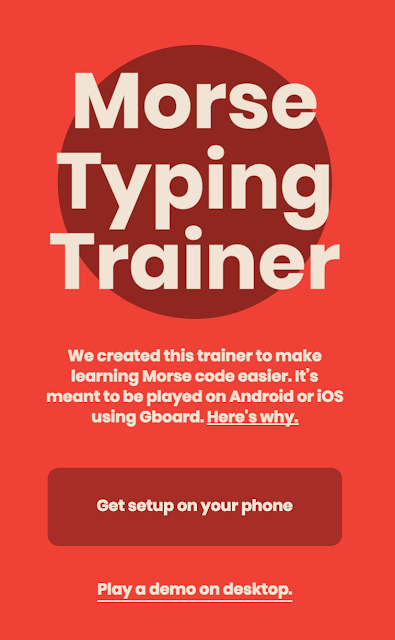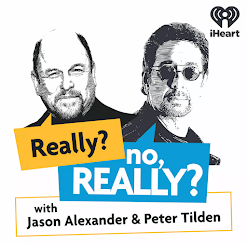Click the pic above (or https://morse.withgoogle.com/learn) and then on Play a demo on desktop to go through the interactive Morse-learning demo. I discovered this thanks to this post from Lifehacker.
Google have arranged things so that smartphone users can type or receive a series of Morse dashes and dots. It's rather good fun and you can also do it on a desktop too (link above). The intention behind this is not just fun but as part of their programme to help people with more accessible communication. In the example given, someone can use head movements to produce either a dot or a dash and the sequence of these is converted into English text (or can be converted into any language).
To introduce this they've also created a really simple and clear method for training people in Morse code (morse.withgoogle.com/learn) which is fun and delightful - really good use of visual design - and I'd learned all the letters within an hour. The morning after I can still remember most of them. Isn't the U for Unicorn (.._) cute.
There are several 'directions' in learning Morse and this uses only one of them. You are given a letter in English - P - and you have to respond with the correct Morse letter - . _ _ . It's quite similar to how I learned to touch-type. First you start with f and j which are the 'home' keys on a keyboard, they have the little raised bit so your fingers can always find them. Then the other letters are brought in and soon you're confidently typing gibberish like fdf dfd jkj kjk and so on and after two weeks you're 50+ words a minute.
'Real' Morse, although no longer in official use (it's not used by the military and I think even amateur 'ham' radio enthusiasts are no longer required to be proficient), would never learn it just like that - you'd hear a series of dots and dashes and have to be able to transcribe back into English letters and numbers, and into words. This system doesn't teach that. Similarly it doesn't teach the reverse in that it doesn't present you with ... _ or _ ... and wait for you to provide V or B respectively (not a criticism, it's really fun and I think it's great and I know more Morse now than I ever did).
Learning Morse uses several 'sensory modalities' in that you have to listen (or see) and press buttons or write and ideally you'd learn to cross-convert an English letter to Morse and a Morse letter to English.
This morning I tried the Morse Code machine tester from Boy's Life (even though I am a girl,
I am fascinated by Morse Code, its history and use, and always feel that I want to be able to make sense of the dits and the dahs. However there's absolutely no reason for me to do so, so no impetus to learn beyond my curiosity.
This enthusiasm probably began about fifteen years ago when I was lying in bed at my parent's house fiddling about with a bedside radio and I came across a radio station broadcasting a series of beeps and beeeeps and wondered what it was. I tried to write them down but of course I couldn't work out where one letter began and ended, or where the sequence started. It took a few listens to make sense of where the spaces were and, with a bit of Googling later and I eventually worked out that the letters were CHT _._. / .... / _ and that it wasn't a radio station but just the Chiltern Non-directional radio beacon for aircraft which was pinging out its location info which my radio had picked up. My parents lived within radio-listening distanced from the Chiltern beacon which is located at RAF Northolt (you can hear it in this old Audioboom of mine). Further googling also led me to this song 'The Slow Train' by Andy Lewis, which features the beacon as a backing track.
Morse is kind of a binary thing (well, not really as there's ON (dot or dash) and OFF (silence) with the transmitting units being built up to form letters, words and numbers. It let people send messages via telegraphy through a series of electrical pulses - not wildly dissimilar to the way in which nerves work - which converted the signal to marks on a bit of paper that were meant to be read. Early telegraphy operators found that they could just as easily translate into dots and dashes the sound the device made as it converted the electrical signal into an indentation on a paper tape. The paper tape became unnecessary and later when Morse was used in radio communications people realised it was quicker just to hear it as an audio transmission rather than as something you translate from a written page. [Wikipedia's page on the history of Morse code]
Below is a picture I took at the Orkney Wireless Museum showing the Morse alphabet. I was surprised to see accented letters.
Further reading
Make your own Morse key USB keyboard
Test yourself in Morse
Quiz: How well do you know Morse code? (27 April 2018, BT)
Morse Code test (1728.org)
A real-world test for certification with the Radio Society of Great Britain









No comments:
Post a Comment
Comment policy: I enthusiastically welcome corrections and I entertain polite disagreement ;) Because of the nature of this blog it attracts a LOT - 5 a day at the moment - of spam comments (I write about spam practices,misleading marketing and unevidenced quackery) and so I'm more likely to post a pasted version of your comment, removing any hyperlinks.
Comments written in ALL CAPS LOCK will be deleted and I won't publish any pro-homeopathy comments, that ship has sailed I'm afraid (it's nonsense).